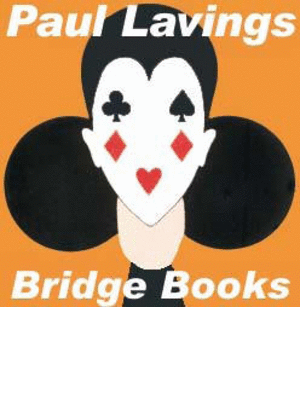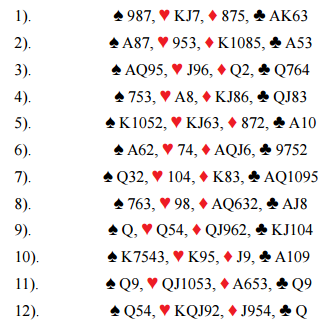Source: ABF
Experts continue to open more and more 11-point hands. Try this quiz at nil vulnerable in fi rst seat. What do you open holding?

1). 1![]() . The bidding at bridge is called the auction, and it really is an auction, except that only two sides are bidding. And as in all auctions, there are a number of advantages in making the first bid. The second positive is that the honour cards are grouped together, and more likely to take tricks. The negatives on this hand are the 4-3-3-3 shape, and the lack of intermediates. But you should still take your chances and open.
. The bidding at bridge is called the auction, and it really is an auction, except that only two sides are bidding. And as in all auctions, there are a number of advantages in making the first bid. The second positive is that the honour cards are grouped together, and more likely to take tricks. The negatives on this hand are the 4-3-3-3 shape, and the lack of intermediates. But you should still take your chances and open.
2). 1![]() . The negative is that you are 4-3-3-3, but you have your share of intermediates, and your hand contains three cards that are likely to make tricks. Also you have four of the suit you are opening, and it is likely to be a good lead.
. The negative is that you are 4-3-3-3, but you have your share of intermediates, and your hand contains three cards that are likely to make tricks. Also you have four of the suit you are opening, and it is likely to be a good lead.
3). Pass. Too many minor honours, all in different suits, and a lack of intermediates, make this a poor hand. If you opened and partner pressed on to game with 12 HCP, you would expect to fail, perhaps by two or three tricks.
4). Pass. No intermediates, and ![]() A is not worth its true value when ace-doubleton. honours in long suits help create more tricks than honours in short suits. Also, you are 3-2 in the majors, indicating you are likely to be outbid, so if you open you will often simply give information to the opponents.
A is not worth its true value when ace-doubleton. honours in long suits help create more tricks than honours in short suits. Also, you are 3-2 in the majors, indicating you are likely to be outbid, so if you open you will often simply give information to the opponents.
5) 1![]() . The suit you are opening has zero lead value, and is only a three-card suit, both negatives. However, you are 4-4 in the majors, and could run away with the contract if you find a 4-4 major suit fi t quickly. Because of your major suit lengths, this is a routine opening.
. The suit you are opening has zero lead value, and is only a three-card suit, both negatives. However, you are 4-4 in the majors, and could run away with the contract if you find a 4-4 major suit fi t quickly. Because of your major suit lengths, this is a routine opening.
6) 1![]() . You have a bit of shape, two aces, and concentrated values in diamonds, indicating a likely source of tricks. The small doubleton should be viewed as a positive. After all, would you rather have Kx opposite Qxxx, or xx opposite KQxx? With both minors it’s my style to open the stronger, creating better lead value. Also if you find a fit in diamonds, it will most likely be a stronger fit on this hand than a 4-4 fit in the other minor.
. You have a bit of shape, two aces, and concentrated values in diamonds, indicating a likely source of tricks. The small doubleton should be viewed as a positive. After all, would you rather have Kx opposite Qxxx, or xx opposite KQxx? With both minors it’s my style to open the stronger, creating better lead value. Also if you find a fit in diamonds, it will most likely be a stronger fit on this hand than a 4-4 fit in the other minor.
7). 1![]() . When you have 11 HCP with a five card suit, you will almost always open. On this hand the two intermediates in your long suit add considerable tricktaking potential to your hand. It would be considered ulta-conservative not to open 1
. When you have 11 HCP with a five card suit, you will almost always open. On this hand the two intermediates in your long suit add considerable tricktaking potential to your hand. It would be considered ulta-conservative not to open 1![]() .
.
8). 1![]() . You have no intermediates, and are weak in the majors. Yet the five card suit, and honours grouped together make this a useful hand. A likely scenario is that by opening the bidding your side competes to 3
. You have no intermediates, and are weak in the majors. Yet the five card suit, and honours grouped together make this a useful hand. A likely scenario is that by opening the bidding your side competes to 3![]() or 3
or 3![]() , and either wins the bid, or pushes the opponents to the three level.
, and either wins the bid, or pushes the opponents to the three level.
9). Pass. A truly horrible hand. The bare ![]() Q is pulling little weight, and the rest of your hand is mostly minor honours. There are six quick tricks to be taken on each bridge hand, four aces and four kings, and this hand has only half a trick. You do not want to be in this auction.
Q is pulling little weight, and the rest of your hand is mostly minor honours. There are six quick tricks to be taken on each bridge hand, four aces and four kings, and this hand has only half a trick. You do not want to be in this auction.
10). 1![]() . A normal 11 HCP, and a routine opening bid. Firstly, your five card suit is a major, secondly most of your points are well placed, and thirdly your
. A normal 11 HCP, and a routine opening bid. Firstly, your five card suit is a major, secondly most of your points are well placed, and thirdly your ![]() 109 could prove the difference. There is a big gap between A32 opposite J54, and A109 opposite J54.
109 could prove the difference. There is a big gap between A32 opposite J54, and A109 opposite J54.
11). Pass. It is unusual to pass 11 HCP with a fi ve-card major, but this lifeless hand has little going for it. ![]() Q and
Q and ![]() Q are in short suits, and not carrying their weight, and the hand has far too many queens and jacks.
Q are in short suits, and not carrying their weight, and the hand has far too many queens and jacks.
12) Pass. Your strong heart suit is a plus, but too many queens and jacks. Plus the singleton ![]() Q is a negative. 11-point hands turn up with great frequency; the hands in this quiz came from three random hand records, totalling 96 hands, and there were many other 11-point hands.
Q is a negative. 11-point hands turn up with great frequency; the hands in this quiz came from three random hand records, totalling 96 hands, and there were many other 11-point hands.
